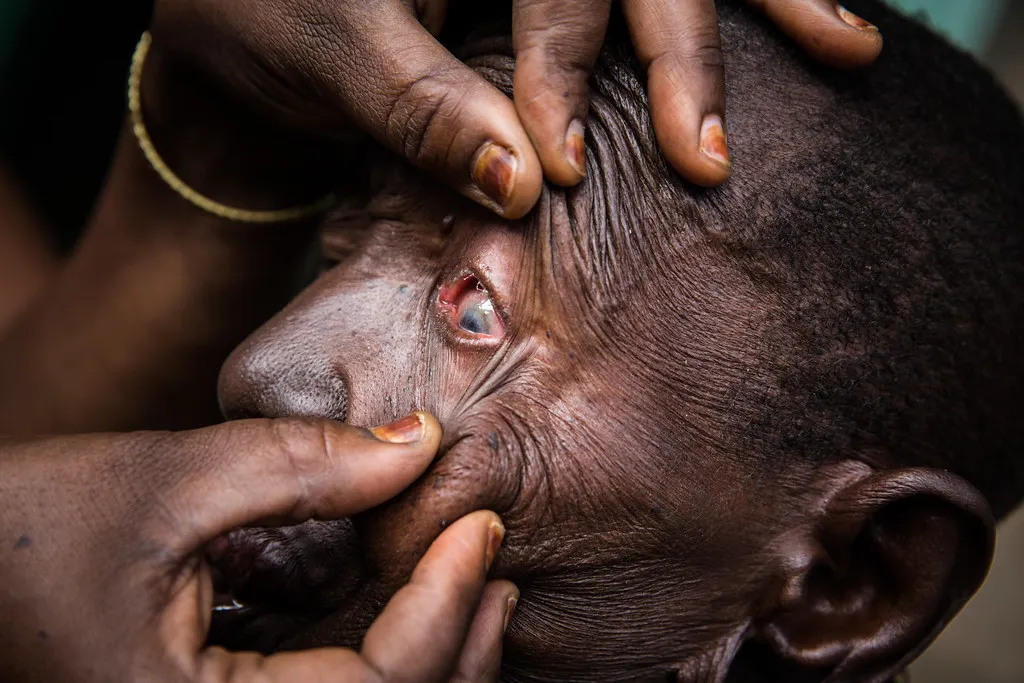Imagine someone close to you starts noticing their vision isn’t as clear as it used to be. They mention seeing halos around lights at night and struggling with glare during the day. These could be signs of a cortical cataract, a common eye condition that often develops with age.
In this blog, we’re going to explore everything there is to know about cortical cataracts. We’ll start by understanding the symptoms that may suggest this condition, delve into the causes behind it, and look at how it progresses through different stages. Most importantly, we’ll go through the treatment options available that can help regain clear vision, detailing what to expect before, during, and after surgery.
Let’s find out how to address and manage this eye condition effectively.
Contents
- 1 What are Cortical Cataracts?
- 2 Symptoms of Cortical Cataracts
- 3 Causes of Cortical Cataracts
- 4 Your Help Can Make a Difference!
- 5 Stages of Cortical Cataracts
- 6 Diagnosing Cortical Cataracts
- 7 Treatment Options for Cortical Cataracts
- 8 Prevention and Management
- 9 Be The Reason To Bring Back Someone’s Vision
What are Cortical Cataracts?
Cortical cataracts are characterized by white, wedge-like opacities that start at the periphery of the lens and work their way to the center in a spoke-like fashion. These are a specific type of cataract that develop in the cortex of the eye’s lens, which is the part that surrounds the central nucleus.
These opacities are caused by the swelling and fissuring of the lens fibers, which disrupts the clarity of the lens and affects the passage of light through to the retina.
How Do They Differ from Other Cataracts?
- Location and Appearance: Unlike nuclear cataracts, which form deep in the central zone (nucleus) of the lens, cortical cataracts begin at the edge of the lens and move inward.
- Progression: They may impair vision more in the peripheral fields initially, unlike nuclear cataracts, which typically impact one’s ability to see at a distance.
- Symptoms: Patients with cortical cataracts often experience problems with glare and scatter, which become more pronounced in bright light. This is because the spokes of the cataract scatter the light as it enters the eye, leading to a decrease in the quality of the visual image.
Understanding these distinctions is crucial for accurate diagnosis and appropriate treatment planning. By recognizing how cortical cataracts form and affect vision differently from other types of cataracts, individuals and healthcare providers can better manage the condition and make informed decisions about the most effective treatments.
Symptoms of Cortical Cataracts
Here’s a concise list of the common symptoms associated with cortical cataracts:
- Blurred Vision: Gradual blurring of vision that worsens over time.
- Glare and Light Sensitivity: Difficulty coping with bright lights, which can cause discomfort or halo effects around lights.
- Reduced Contrast Sensitivity: Trouble distinguishing objects from their backgrounds, particularly in low light.
- Color Perception Changes: Colors may appear faded or yellowed.
- Frequent Prescription Changes: Needing frequent updates in the prescription for glasses or contact lenses.
Causes of Cortical Cataracts
Here are common causes associated with the development of cortical cataracts:
- Aging: The most common cause, as changes in the lens structure occur naturally over time.
- Diabetes: High blood sugar levels can alter the lens’s metabolism and structure.
- Ultraviolet Radiation: Prolonged exposure to UV light from the sun can damage the lens.
- Steroid Use: Long-term use of corticosteroid medications can increase the risk of cataract formation.
- Smoking: Tobacco use has been linked to an increased risk of various types of cataracts, including cortical cataracts.
- Alcohol Consumption: Excessive alcohol intake may contribute to the development of cataracts.
- Nutritional Deficiency: Lack of antioxidants in the diet can impact lens health.
- Eye Injury: Trauma to the eye can accelerate cataract formation in some cases.
- Family History: Genetic factors may predispose individuals to earlier or more significant cataract development.

Your Help Can Make a Difference!
Cataract Is The Biggest Reason For Blindness!
With Every Donation, You’re Gifting a Cataract Surgery To Someone in Need!
Stages of Cortical Cataracts
Cortical cataracts progress through various stages, each marked by an increase in symptom severity and impact on vision. Let’s have a look at these stages:
Early Stage
- In the early stages, cortical cataracts begin as slight opacities on the outer edge of the lens cortex. These opacities are often wedge-shaped or resemble spokes pointing towards the center of the lens.
- Individuals may experience slight blurring of vision and some difficulties with glare, especially at night.
Intermediate Stage
- As the cataract progresses, the opacities become denser and start to spread closer towards the center of the lens. This growth leads to more significant disruption of light passing through the lens.
- Vision becomes more blurred and clouded. Problems with glare and light sensitivity increase, and contrast sensitivity decreases, making it harder to perceive visual details and affecting color perception.
Advanced Stage
- In the advanced stage, the opacities cover most of the lens, significantly affecting its transparency and leading to substantial vision impairment.
- Visual acuity is severely reduced. Colors may appear significantly faded or yellowed, and seeing in low light conditions becomes particularly challenging.
Mature Stage
- At this final stage, the entire lens becomes cloudy, and opacification is complete.
- Now, the vision is profoundly affected, potentially leading to functional blindness if not treated. Individuals at this stage are unable to see fine details and may only distinguish light from dark.
Diagnosing Cortical Cataracts
Diagnosing cortical cataracts involves a thorough eye examination by an eye care professional. Here’s what typically occurs during the diagnosis of cortical cataracts:
- The eye doctor will start by asking about your vision problems and any symptoms you’ve noticed.
- Then a few eye exams would be conducted. Some of them include: visual acuity test, slit lamp examination, and pupil dilation.
- Additional Tests which may include: Tonometry and Retinal Examination.
- The eye doctor will discuss the findings with you, explaining the presence and extent of any cataracts detected and how they are impacting your vision.
- If cataracts are found, the doctor will discuss potential treatment options, timing for surgery if needed, and what outcomes you might expect.
By conducting a comprehensive diagnostic process, eye care professionals can accurately identify the presence and severity of cortical cataracts. This detailed assessment is crucial in developing an effective treatment plan tailored to your specific needs and vision goals.
Treatment Options for Cortical Cataracts
When it comes to treating cortical cataracts, the primary and most effective option is surgical intervention. Here are the key treatment options available:
- Phacoemulsification: This is the most common and preferred method for cataract surgery. The procedure involves using ultrasound waves to break up the cloudy lens into small pieces, which are then suctioned out of the eye. A clear, artificial intraocular lens (IOL) is then implanted to replace the natural lens. Phacoemulsification is favored due to its high success rate, minimal invasiveness, and rapid recovery time.
- Extracapsular Cataract Extraction (ECCE): In cases where the cataract is too dense for phacoemulsification, ECCE may be employed. This procedure involves removing the cloudy lens in one piece instead of fragmenting it. It requires a larger incision, which may lead to a longer recovery period compared to phacoemulsification.
Surgery is generally recommended when cataracts begin to significantly interfere with daily activities, such as driving, reading, or using a computer. The decision to proceed with surgery should be made in consultation with an eye care professional who can assess the specific needs and health conditions of the patient. With modern surgical techniques, the treatment of cortical cataracts is highly successful and can dramatically improve quality of life.
Prevention and Management
While cortical cataracts often develop due to aging, there are several practical measures that individuals can take to protect their eye health and potentially reduce the risk of developing cataracts. Here are some effective strategies for prevention and management:
- Wear sunglasses that block 100% of UV rays to protect the eyes from harmful ultraviolet light.
- Use wide-brimmed hats to shield your eyes from direct sunlight, further reducing UV exposure.
- Eat vegetables and fruits like carrots, spinach, and berries contain nutrients that are vital for maintaining healthy eyes.
- Consume foods rich in omega-3 fatty acids, such as fish.
- Schedule regular eye examinations, especially as you age.
- Always discuss any changes in your vision with an eye care professional, even if they seem minor.
- Quit smoking
- Limit Alcohol Consumption
Implementing these preventive measures can help maintain eye health and reduce the risk of developing cortical cataracts. Additionally, these habits contribute to overall well-being and support the health of other organs, not just the eyes.
Be The Reason To Bring Back Someone’s Vision
As the incidence of cataracts continues to rise, significantly increasing the rates of blindness worldwide, many individuals find themselves in dire need of treatment they cannot afford. This is where your support can create a transformative impact.
Imagine being the reason someone gets to experience the beauty of the world again. With your help, we can make this a reality for countless individuals. Even a small donation from you can help us give someone the gift of sight!
Join Hands with EyeMantra Charitable
Our mission is to reach as many people as possible who are in desperate need of eye care.
We urge you to take action today. Click on the Donate Now button to start making a difference.
